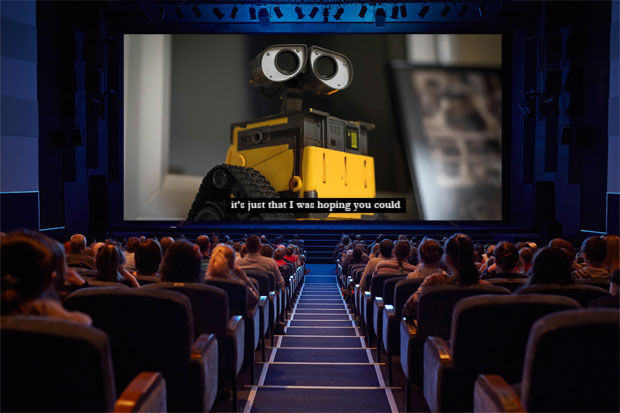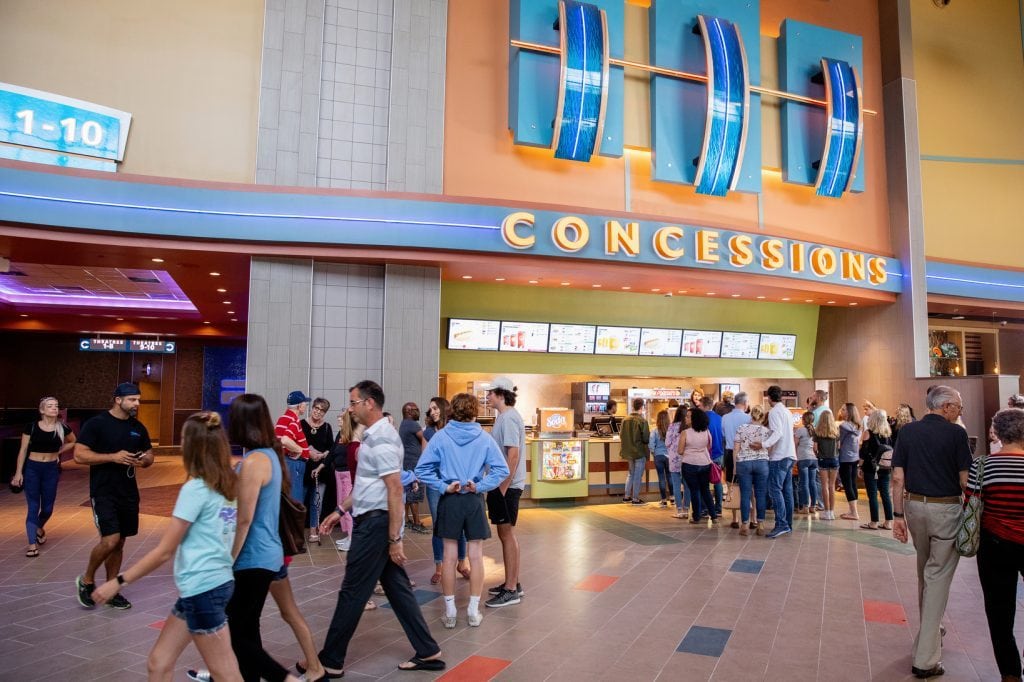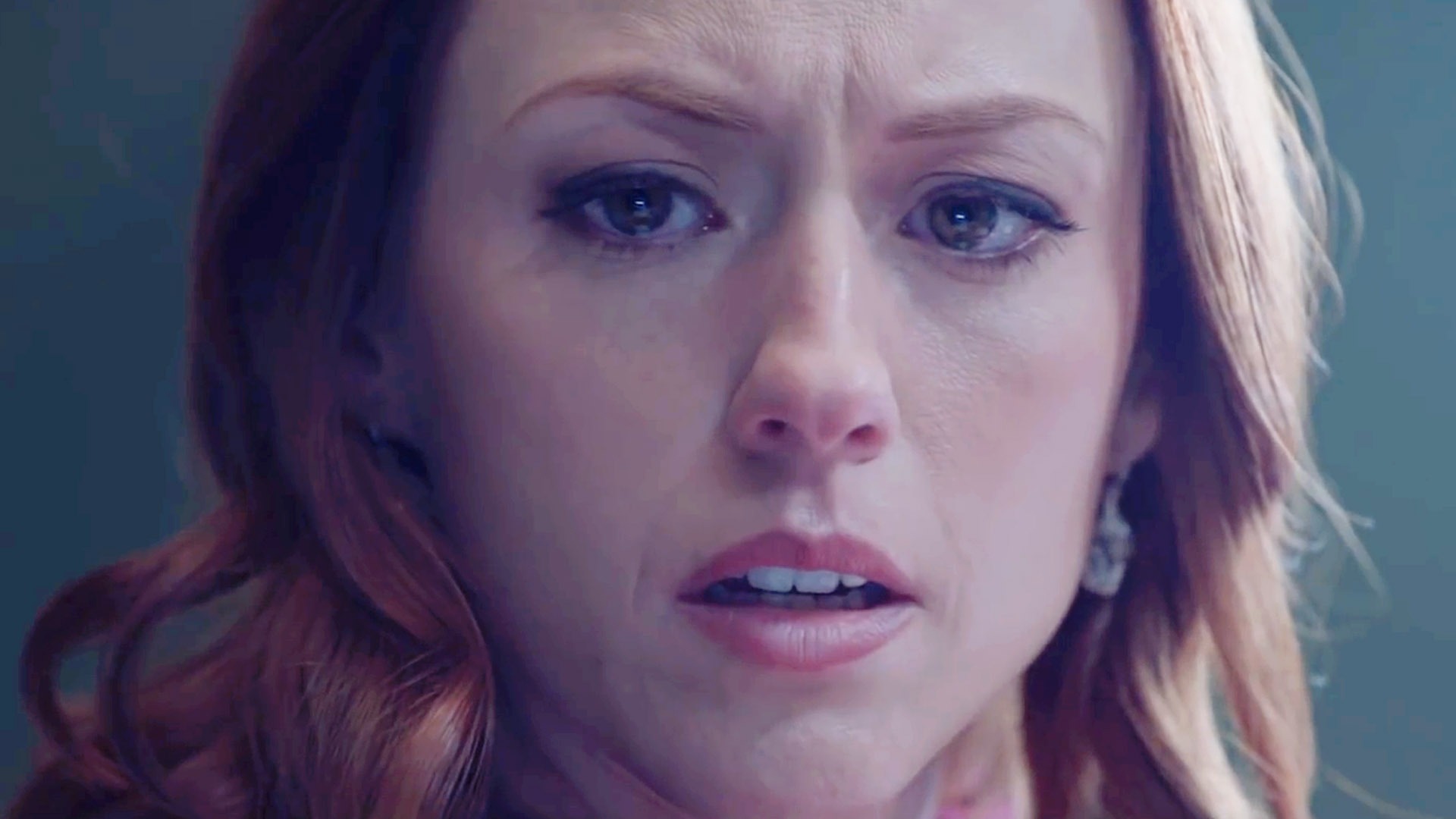Take, for example, the news that the Lakewood Ranch Cinemas will be screening movies once more beginning with a "soft" reopening March 31 and the official opening date of Friday, April 2. Meanwhile, Sarasota's SFS venue, downtown's Burns Court Cinema, is still working on plans to open its doors to lovers of independent and foreign films again soon. After the escalation of the novel coronavirus pandemic, the shutdown of businesses across America, and the delay of major tentpole releases previously scheduled throughout 2020, new movies are now opening exclusively in theaters again. But as the disease recirculates in waves, chains like AMC, Regal, and Cinemark have struggled, with some theaters reopening and then shuttering again, while others closed permanently. As COVID-19 continues to be a prevalent issue in many parts of the United States and around the world, the safety, practicality, and availability of movie theaters remains in question.
Canada's largest movie theaters over the years have been located in Toronto. As mentioned above the 18- (later 21-) screen Cineplex was the movie theater with the most screens in the world until the late 1980s, but remained the largest movie theater in Canada until it was closed at the turn of the 21st century. In 1998, AMC expanded to Canada, building large movie theatres with as many as 24 screens before opening a 30-plex there in 1999, which is the AMC Interchange 30. Then in 2008, the 24-screen AMC Yonge Dundas 24, adjacent to the Eaton Centre, was completed. Cineplex Entertainment purchased the theater in 2012, along with several other Canadian AMC megaplexes, bringing the company full circle.
Any place where people gather together was hit hard by the pandemic. But movie theaters, being almost exclusively indoor-only locations have had a more difficult time than other industries finding ways to adjust. Theaters are open around the nation now, although seating is still largely limited to a fraction of maximum capacity, and there still isn't all that much being released in theaters to go see. But it's possible that could all change in less than two months, as New York City, which has been one of the most restrictive places in the country for movie theaters, expects to have them open to full capacity by July 1st. Although movie theaters in most of New York State were allowed to reopen in October, those in its filmgoing capital, New York City, remained closed because of the pandemic.
But early last week, Gov. Andrew M. Cuomo gave cinemas in the five boroughs the go-ahead, setting an opening date of March 5. After 14 months of closure during the coronavirus pandemic, Israel's movie theaters are set to reopen on Thursday. The country's main cinema chains will be opening their doors to the broader public – including children – according to a plan soon to be announced by the Health Ministry. By 1994, building of multiplexes with screens with 2,500 to 3,500 seats was the norm. The expansion of multiplexes also concentrated the market with the top ten exhibitors controlling 47% of the nation's screens compared to 27% in 1986.
The AMC Grand 24 opened in Dallas, Texas, on May 19, 1995, as the first 24-screen megaplex built from the ground up in the United States and the largest theater complex in the U.S. A 21-screen Edwards Theater opened at the Irvine Spectrum Center in Irvine, California, the same year. After a lease renewal dispute with the property owner, the AMC Grand 24 closed in November 2010.
The building has been divided and reopened in 2012 as a Toby Keith–owned nightclub and a 14-screen first-run movie theater operated by Southern Theatres as the "AmStar 14". This theatre is now the Studio Movie Grill Northwest Highway as of 2013. Based on this data, it is evident that primarily the lower grossing movie theaters and the ones with fewer screens are those that have not operated at any point since the pandemic forced them to close.
Drive In Movie Theater Near Me Open Today Given the restrictions and security measures in place movie theaters with more screens often have a wider range of tools to maintain their business. I talked to folks from all kinds of backgrounds across the US and the UK to try to answer this question, and I got a bunch of different responses. But what most people told me, after a year of watching movies only at home, is that they go to theaters for three reasons. Two, they value the loss of control that's inherent to movie theaters, the commitment to being in a space and paying attention to the experience the filmmaker has created. And three, they long to have their perspective shifted on the outside world in a way that's tough to replicate at home.
And so, I've been skeptical of the speculation that people won't go to theaters post-pandemic because we've gotten used to watching movies at home. It's not like no one was streaming movies at home before Covid-19 began to spread. As with everything in life during uncertain times, the answer boils down to a personal choice made by an informed decision. We encourage our readers to follow guidelines provided by the CDC, health authorities, and theaters to determine whether attendance is right for them. Megaplex theaters may have stadium seating or normal seating, and may have other amenities often not found at smaller movie theaters; multiplex theatres often feature regular seating. Of course, movie theaters being able to allow full capacity doesn't mean they'll be able to achieve such numbers.
While a lot of people may be ok going to movie theaters that are full, many, including some that are vaccinated, may be hesitant to do so. How quickly we really return to normal will depend more on the decisions of individual people than it will what is allowed by the various governing bodies. After all this time it seems almost insane that we could see movie theaters at full capacity in less than two months, but it's maybe not that crazy. Most of California is currently allowing movie theaters to be open at 50% capacity, including Los Angeles County, which has also been an area of more severe restriction for some time. As vaccinations rates have been increasing the speed with which things have been reopening has also sped up, so perhaps full movie theaters in two months can be a reality.
Fithian said a few independent movie theaters and drive-ins have been able to continue operating by showing classic films or rereleases. Fithian said by this Friday, 70% of the movie theaters in the U.S. will be back in business, though not in Los Angeles or other cities where the coronavirus numbers are still high. The government Tuesday issued guidelines for the reopening of cinema halls and multiplexes from October 15. As per the new Unlock 5 guidelines, cinemas and multiplexes have been allowed to reopen with 50 percent seating capacity. On Tuesday, the Ministry of Information and Broadcasting (I&B) earlier today released Standard Operating Procedures which need to be followed by all cinema halls and multiplexes.
The described disparate allocation of the market share of open theaters and percentage of physical sites operating correlates with the number of screens these locations have. The movie theaters that were closed for the last 11 months entirely generally have a lower number of screens. In fact, more than half of them (55%) have five or fewer screens. This is significantly higher than the norm (42%) of all movie theaters in the US. Of the movie theaters currently open only 32% have five or fewer screens. In the meantime, there are currently 42 cinemas open in Los Angeles County, according to Comscore.
Film exhibition industry officials expect that number to increase as capacity restrictions are loosened. Comparatively, Los Angeles County had 107 movie theaters open at this time in 2019. Los Angeles County's move into the red tier this week paved the path for movie theaters to reopen, with COVID-19 modifications.
The biggest rule for movie theaters under the red tier in California's plan for safely reopening counties during the pandemic centers on capacity. One big question for movie theaters moving forward is the change around theatrical "windows," the time between when a movie is released in theaters and when it's available to view at home. After a year of shuttered theaters, capacity restrictions and home streaming, local movie theaters have fretted about how their industry would fare as Massachusetts lifts its COVID-19 restrictions. As of now, local theaters say the mood is mostly cautious optimism. While the museum has now had the experience of being open during the pandemic, Roy said, translating what happens in galleries to the theatrical experience isn't straightforward. "It's not a direct overlay in terms of procedures and time spent in one area," he said.
The staff has mapped the cinemas and even with the capacity restrictions can fit in a "decent" number of moviegoers. Still, he wants to avoid a situation in which there are "crickets in the room because there's not a comfort level yet in coming back." He's envisioning reopening with something that will be a "delight" to watch on a big screen. MUSEUM OF MODERN ART The museum itself reopened in August, but its movie theaters are still closed for now. "The methods we had developed for a potential reopening last summer or fall, when I think all of us were hoping cinemas could reopen, they don't really apply I think the same way anymore," said Rajendra Roy, the chief film curator. He cited both advances with vaccines and questions surrounding new variants. Even as DVDs and then Blu-rays became commonplace, and streaming services arrived in the late aughts, the reasons for going to a movie theater remained about the same.
There were blockbuster releases and goofy comedies and horror movies to see. For a whole lot of people, movie theaters were knit into our lives. The Kinepolis-Madrid Ciudad de la Imagen megaplex has been the largest movie theater in the world since 1998, with 25 screens and a seating capacity of 9,200 including a 996-seat auditorium. Kinepolis-Valencia, built in 2001, boasts 24 screens and 8,000 seats. On Friday, for the first time since the pandemic hit last March, movie theaters will be allowed to reopen—and quite a few NYC spots are prepared to welcome guests. Gov. Andrew Cuomo announced the changes Monday, saying all movie theaters in the state can reopen starting March 5.
Most of the theaters outside the city had already started to reopen after an October order allowed them to do so with limited capacity and COVID-19 safety measures. The movie theaters that haven't re-opened in the last 11 months were, in general, lower grossing locations. While the 1,210 movie theaters that last reported in March 2020 are 23% of all tracked US movie theaters, they represent just 18% of the market share. In contrast the locations currently open in February are 42% of the tracked US movie theaters representing 43% of the market share, thus slightly over-indexing in box office performance. Since last March, Loudouners have used their living room as movie theaters, downsizing their screens from 50 feet to 50 inches.
But now, half of the county's movie theaters are open and showing films every day of the week, and they're expecting a turnaround in 2021. As for those streaming platforms, it's unclear how much they'll impact moviegoing once things return to a relative state of normalcy. If people can watch brand-new blockbusters from the comfort of their homes, the more pessimistic readings went, they'll never be inclined to return to theaters, even in a fully post-COVID world. But the developments in China suggest that isn't the case at all. The number of people being vaccinated has risen while positive COVID-19 case numbers have dropped, allowing the state to loosen some restrictions that have been in place since spring 2020. Some movie theaters have continued to operate with safety guidelines in place, including taking temperatures, keeping people separate from one another and requiring masks.
The red tier of California's reopening plan, which Riverside County qualified to move into on Tuesday, allows for movie theaters to reopen and operate at 25% capacity. As of March 7, 15 percent of adults said they would feel comfortable returning to movie theaters in the next two to three months. One-third said it would be more than six months before they visited a cinema again. Megaplex Theatres — a movie theater chain that had its beginnings in Utah but has expanded to Idaho and Nevada — has been one of the few movie theaters to remain open during the entire pandemic. The theater chain has done things outside of just showing movies. It's hosted food and toy drives, became a polling place during the 2020 election and most recently, has used its theater locations as vaccination sites for the coronavirus vaccines.
The Kinepolis-Madrid Ciudad de la Imagen megaplex in Spain is the largest movie theater in the world, with 25 screens and a seating capacity of 9,200, including one 996-seat auditorium. After almost five months, the box office is allowed to open for moviegoers today, but many Upstate theaters will remain closed awaiting studios to release their movies. After months of closure forced by the new coronavirus pandemic, movie theaters in metro Phoenix and across Arizona have reopened. Indoor movie theaters in Philadelphia are allowed to reopen on Sept. 8, as city Health Commissioner Thomas Farley announced last month.
And New Jersey movie theaters can reopen on Friday, Sept. 4, as Gov. Phil Murphy announced Monday. Movie theater owners are optimistic by the gradual reopening of Los Angeles. Even with capped capacity and more than half of locations still shuttered, the county accounted for 9% of all movie tickets sold last weekend, according to Comscore.
Having more theaters open will likely bode well for upcoming releases like Universal's thriller "Nobody" with Bob Odenkirk , "Godzilla vs. Kong" and "Mortal Kombat" . Restrictions are the same in Boston, but are tighter in Cambridge, where indoor capacity is capped at 50 people. Certain chains have opened around the country under comparable strictures. AMC plans to open all its theaters this weekend in the city, the country's second-largest movie market; Regal is holding off until the top market, Los Angeles, reopens.
But the guidelines pose special difficulties for New York's independent theaters and art houses. Below is a roundup of which plan to return on Friday or in the near future and which will stay shut for now. By 2004, only 25% of movie theaters in the United States had one screen and there were over 500 multiplexes with more than 16 screens. In 1985, AMC Cinemas opened a ten-screen cinema at The Point in Milton Keynes. This was AMC's first multiplex outside of the United States and saw a turnaround in the decline of the UK cinema industry.
By the end of 1992, the 5 major exhibitors had built 525 multiplex screens in the last eight years in the UK, with cinema admissions increasing from an all-time low of 54 million in 1984 to over 100 million. The increase in multiplexes led to 77% of the UK's screens being owned by the 5 major exhibitors. The increase in multiplexes around the country also reduced the importance of London from a revenue standpoint.
In July 2000, Star City, Birmingham opened with a 30-screen Warner Village Cinemas (now a 25-screen Vue Cinemas with 5,079 seats), at the time the largest cinema in Europe. A multiplex is a movie theater complex with multiple screens within a single complex. Sometimes, an existing venue undergoes a renovation where the existing auditoriums are split into smaller ones, or more auditoriums are added in an extension or expansion of the building. The largest of these complexes can sit thousands of people and are sometimes referred to as a megaplex. If we can expect movie theaters in New York city to be at full capacity on July 1, that it seems likely that will be the case across the country, considering NYC has been moving slower than most other places when it comes to reopening. Still, Fithian said the movie theater business may never be the same.
Recently, the biggest theater chain, AMC, made a deal with Universal that enables it to release its movies on premium video on demand soon after they premiere. It may shrink the amount of time Universal films play in AMC theaters, but Fithian said he's confident audiences will still want to go to the movies. Gill said his strategy has drawn a lot of attention for Unhinged. But he knows that people in the U.S. may think it's still too dangerous to gather at indoor movie theaters. "There's also the risk that they've just gotten so comfortable with streaming movies that you can't get them out of the house — so there are a lot of risks," he said. "Polling suggests there is a ton of pent-up demand. Forty percent of the audience that was surveyed the other day said they would go to the movies no matter what it was when they open. So OK, that would be incredible."
The graph below highlights these in detail, with the state's market share of theaters in dark blue and the percentage of physical locations across the state in orange. On the left, for the movie theaters closed continuously since March, all orange bars are clearly bigger than the dark blue bars. This is opposite among movie theaters currently open, displayed on the right.
At that time, movie theaters will be able to raise indoor capacity from 25% or 100 people to 50% capacity or 200 people . Mary Pickford is D'Place is also following guidelines provided by CinemaSafe, which is an alliance of more than 435 movie theater companies and commissioned by the National Association of Theatre Owners. CinemaSafe advises theaters to enforce mask wearing, social distancing, eliminate concessions requiring utensils or shared equipment, and thorough cleaning. When it comes to theaters, the status of movie theaters depends on the state where they're located, or even the city. Some states are fully back at 100% theater capacity, while others have imposed social-distancing guidelines. Children below the vaccination age make up a sizable portion of the movie-going public, and theaters preferred to remain closed rather than lose that audience.
Click on their website links to read all their coronavirus precautions. The first new movie since the coronavirus pandemic shuttered movie theaters opens around the country on Friday. An audacious road rage movie, Unhinged stars Russell Crowe as a man who relentlessly hunts down an impatient woman after she honks and passes him at a traffic stop. As per the guidelines, cinemas, theatres and multiplexes will be allowed to open from October 15, almost seven months since lockdown was imposed. Auditoriums, however, will be allowed to operate with only 50 per cent capacity.
When the pandemic fades and the market moves ahead on the road to recovery it will be noteworthy to see how many of the longest closed movie theaters will turn on the lights again. Some have already had to close permanently, such as Charlotte, North Carolina's oldest movie theater the Regal Manor Twin, which had been in operation since 1947. Let's hope most of those yet to re-open will have the resources to return, adapt to market challenges and flourish when they are able to do so.
Almost a year has passed from when the number of movie theaters operating in North America started to sink significantly due to the COVID-19 crisis. Nearly a quarter (23%) of all US movie theaters have stayed closed since March 2020! These locations generated a combined yearly box office of $1.8 billion on average in 2018 and 2019.


























No comments:
Post a Comment
Note: Only a member of this blog may post a comment.